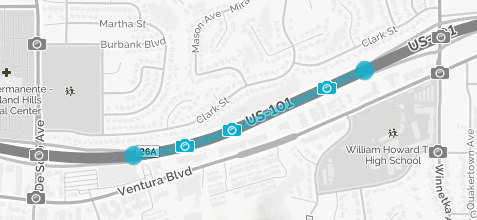GetCamerasForIncident Method
GetCamerasForIncident returns a set of cameras that may have a view of an incident, sorted by likelihood.
All cameras are pre-assigned zero or more associated TMC segments. Any camera with an assigned TMC segment that matches the given TMC segment will be returned. There may be no cameras returned if there are none with a possible view of the given segment.
 In this example, only the cameras with a view of the blue TMC segment will be returned
In this example, only the cameras with a view of the blue TMC segment will be returned
Syntax
GetCamerasForIncident2(string strTMC, string strRoadNames, int intOptions, string strPassword)
Parameters
| Name | Type | Description |
|---|---|---|
| strTMC | string |
The TMC code associated with an incident.
Note that the “+” character in any TMC must be percent-encoded. Note that some environments and applications (e.g., .NET) automatically perform percent encoding, while others (e.g., typing directly into most browser address bars) do not. |
| strRoadNames | string |
List of up to 1,000 road names delimited by the or symbol ( ‘|’ ).
This parameter is required, but may be left blank.
If one or more road names are supplied, only cameras with names containing one of the supplied road names are returned.
If no road names are supplied, all cameras are returned.
The method treats certain variations on road names as equivalent,
e.g. “Street”, “St”, “St.” are all equivalents, “Highway”, “Hwy”, “Hwy.” are all equivalents, and "I-5", "I5" are equivalents.
Note: While the method allows up to 1,000 road names, the maximum number that can be listed in a URL query string in a browser is limited. |
| intOptions | int |
A set of bitwise flags OR’ed together:
If intOptions is OR’ed with the value 1, only cameras which have streaming video URLs will be returned. Otherwise cameras which provide still images only and cameras which provide both still images and streaming video URLs are returned. If intOptions is OR’ed with the value 2, cameras which have the DetectedOutOfService field set to False are guaranteed to be in service for the next 10 minutes. To establish the guarantee, an image is retrieved for every camera inside the bounding box and cached. This can significantly increase the execution time for this method. If intOptions is OR'ed with the value 4, cameras from pending new regions are included. These pending cameras are for demonstration purposes only and this option must not be used in production systems. If intOptions is OR'ed with the value 8, a “TemporaryPassword” field will be returned for each camera. The temporary passwords will be good for 1 hour after the time of the call to GetCamerasForIncident. Unlike the main password, temporary passwords may be exposed to the end user. If intOptions is OR'ed with the value 16, only cameras which are hotspot cameras will be returned (see Hotspot Cameras for more information). Otherwise both fixed cameras and hotspot cameras will be returned. If intOptions is OR'ed with the value 32, only cameras which have the DetectedOutOfService field set to False will be returned. Otherwise out-of-service cameras will be included. If intOptions is OR'ed with the value 64, only cameras which have the Visibility field set to Low will be returned. |
| strPassword | string | Unique id/password supplied to you previously. |
Return Value
Type: XML
For fields for each returned camera, see GetCamerasInBox.
Example
| Request |
|---|
| https://www.vizzion.com/TrafficCamsService/TrafficCams.asmx/GetCamerasForIncident2?strTMC=C23P05347&strRoadNames=&intOptions=0&strPassword=<password> |
| Response |
|---|
| For format, see GetCamerasInBox. |